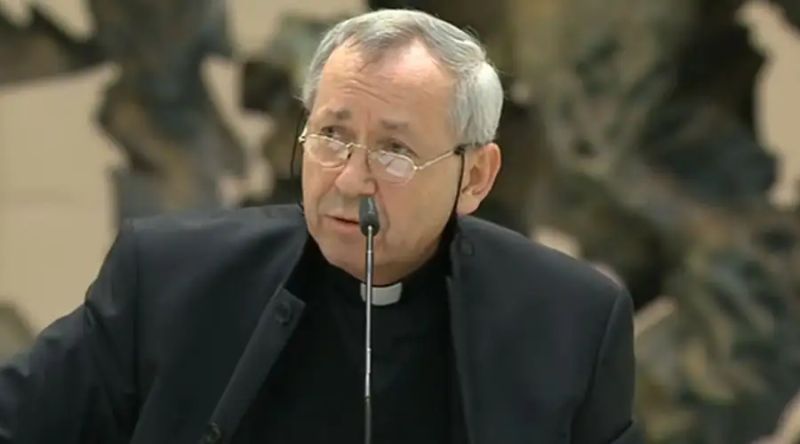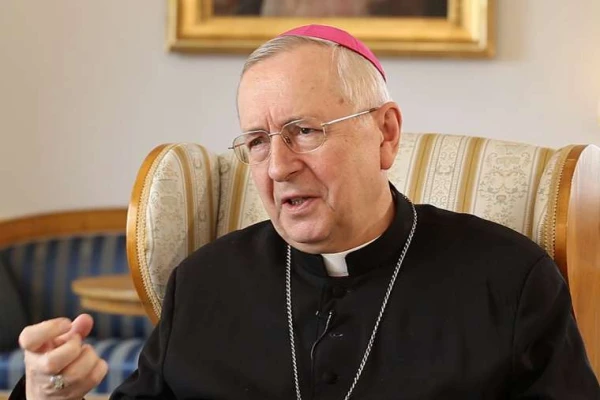
ACI Prensa Staff, Apr 17, 2023 / 11:00 am (CNA).
Various media reported that Father Marko Rupnik, accused of having sexually abused numerous nuns, could leave Rome and be assigned to a residence for priests in Milan, Italy.
The source of the rumors was Father Miran Žvanut, superior of the Society of Jesus in Slovenia, who told the Slovenian weekly Reporter that the accused priest will be forced to leave the Italian capital and live confined to the Aloisianum in Gallarate, the home for elderly priests of the Society of Jesus in the Diocese in Milan in northern Italy.
Asked about these alleged statements, Rupnik’s superior, Father Johan Verschueren, who is also the delegate of the Society of Jesus for Houses, Works, and Interprovincial Jesuits in Rome, told ACI Prensa, CNA’s Spanish-language news partner, that those statements will remain “on the the Reporter’s record.”
He also stressed that Rupnik “only has one major superior — that’s me. Therefore, I am dealing with the case, and I will not comment on the proceedings still going on now.”
“In fact, I only deal with Father Rupnik’s case within the limits described by canon law, no more and no less,” he said.
Milan’s response
The Aloisianum of Gallarate in Milan told ACI Prensa that it is not aware of this information and that it has not received any notification from the Society of Jesus about the possible transfer of Rupnik.
The Aloisianum was founded in 1839 as a seminary for aspiring Jesuits. Dedicated to St. Aloysius Gonzaga, its name derives from Aloisius (Louis in Latin). In the 1970s it ceased its university program, remaining as the residence of the Jesuit community.
The Aloisianum is also noted for being where Cardinal Carlo Maria Martini, the former archbishop of Milan, studied and died.
In a statement to ACI Prensa, Verschueren also denied that the Aletti Center, the art school dedicated to the promotion of religious art founded by Rupnik in Rome, is going to be dissolved.
“This is simply impossible. The Aletti Center is under the ecclesial authority of the vicariate of Rome,” he explained.
The Rupnik case
The Jesuit order has received accusations against Rupnik that span from 1985 to 2018 and include claims of spiritual, psychological, and sexual abuse, and abuse of conscience, all involving adult nuns.
In May, 2018, the Congregation for the Doctrine of the Faith formally declared that Rupnik had committed the excommunicable act of absolving an accomplice of a sin against the Sixth Commandment and that the priest was in a state of excommunication, which was lifted by CDF decree later the same month. Rupnik also then ceased to be director of the Aletti Center.
In recent months other cases of the abuse of women related to the Aletti Center have been sent to the Jesuit headquarters in Rome.
According to current restrictions imposed by the Jesuit order, Rupnik is prohibited “from any public ministerial and sacramental activity,” banned from public communication, ordered not to leave Lazio, and “may not engage in any public artistic activity, especially in relation to religious structures (such as churches, institutions, oratories and chapels, exercise or spirituality houses).”
This story was first published by ACI Prensa, CNA’s Spanish-language news partner. It has been translated and adapted by CNA.
If you value the news and views Catholic World Report provides, please consider donating to support our efforts. Your contribution will help us continue to make CWR available to all readers worldwide for free, without a subscription. Thank you for your generosity!
Click here for more information on donating to CWR. Click here to sign up for our newsletter.





(Sigh.)
I would say that the mission best suited to Rupnik’s proclivities would be San Quentin.